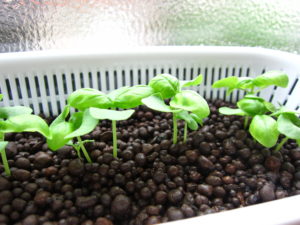Using Rockwool Cubes in Hydroponics
If you do any research into hydroponics, you know that growing medium is absolutely essential. Of course, you probably also know that rockwool is a quintessential growing medium. It’s great as a seed starter, as well as a popular growing medium for hydroponics. A lot of growing media is pretty straightforward. So what is it that makes rockwool so different?
How rockwool is made
Rockwool is made by super-heating chalk and basalt rocks to extremely high temperatures of at least 1600° C (2912°F). This creates a man made lava-type form, which then goes into a chamber which cools the material whilst spinning it. This then creates fibers from the cooling, spun material, which resembles a wool, or as some say, cotton candy.
Much like the process for creating cotton candy, the result is a highly expanded, fibrous material, although the starting material is much smaller, and much more compressed.
In fact, it only takes one cubic foot of rocks to create 37 cubic feet of rockwool.
After the ‘spinner’ creates the fibrous form of rockwool, it needs to be shaped into a form that works for agricultural use. The rockwool fibers then go through the compression process, and gain a flat, mat-like shape. After forming the ‘mats’ the manufacturer forms the rockwool into smaller slabs or cubes that are easier for the end user to handle.
How Rockwool is Different to Other Growing Media
Some growing media, like clay pebbles (also known as Hydroton), do need to be heated to high temperatures to come into their final form. While that’s part of the process of creating rockwool, it also needs to be formed into fibrous strands. However that’s not the only difference betweewn rockwool and other growing media. You might use perlite or vermiculite in your backyard garden, but it’s pretty unlikely that you’ll end up using rockwool.
That said, there are some differences you should take note of before you decide on rockwool as your growing medium of choice. The #1 thing to know about rockwool is that it naturally has a high pH. In fact, the pH is so high that you need to prepare it before you use it to grow hydroponic plants. Don’t worry. Preparing rockwool doesn’t take a chemistry degree. But- it does take a little time (and very little effort).
Of course, rockwool also comes in a slab or cube form, where a lot of other growing media is in a more granulated form. The unique form of rockwool makes it a great choice for starting seeds and rooting clones. Once your plants take root, you can transfer them right into your hydroponic system.
How to Prepare Rockwool
What can you do?
First get:
- a bowl
- some water pitchers
- a mask
- a space to work outdoors
Of course, if you’re using a hose, you can skip the water pitchers. The point is to thoroughly rinse your rockwool. The mask is for making sure you don’t accidentally inhale small, fibrous particles of the rockwool that come out when you first handle it.
Some people rinse their rockwool and soak it for a couple of hours to even out the pH. However, some people also soak rockwool for up to 48 hours. If you want to be on the safe side, 24 hours is perfectly fine.
Rinse the rockwool thoroughly, and remember not to squeeze it. It’s definitely tempting- rockwool can have a somewhat spongey texture because it leaves so much room for air. But that’s also what makes rockwool such a good growing medium. There’s a lot of space between the fibers which allows plenty of air in, while also allowing plenty of liquid to travel through. If you squeeze the rockwool, you’re destroying one of the properties that makes it so valuable for hydroponics.
Once you’re done waiting for your rockwool to soak, give it a final rinse off, dispose of the old water, and get ready to use your new growing medium.
Note: a lot of rockwool cubes designed for hydroponics come with holes already in place for plants. If yours doesn’t, that’s not a big problem, you can make the holes yourself. Just make sure the tools you use to make the holes are totally sterile.
Start Seeds in Rockwool
As we mentioned, a lot of rockwool comes with holes already in the cubes. That makes it especially easy to start seeds in rockwool cubes. Most growers like to put a couple seeds in each hole, in case one of the seeds doesn’t sprout, or one plant ends up weaker than the other.
After you prepare the rockwool, it should still be somewhat moist. Put the rockwool on a growing tray, and get your seeds ready. Just place your seeds in the holes, and let them germinate. You can also cover the rockwool with a dome top to retain humidity and help seeds to germinate faster.
It’s really that easy. Once you have some seedlings, let them grow to a couple inches tall before you transplant them. Another way to tell that your seedlings are ready to transplant is that they grow a couple ‘true’ leaves. These leaves are different from the embryonic leaves that plants have once they sprout from the seeds. After that, they should be ready to thrive in your hydroponic system.
Another tip: Some hydroponic systems might not keep rockwool cubes stable enough on their own. If necessary, you can put the rockwool in a netted cup and place another grow medium, like clay pebbles, around the rockwool cube.
Not sure where to start?
We recommend this pack of Rockwool cubes– it’s an expensive growing medium, it comes with pre-made holes for seeds, and it’s very easy to work with.



